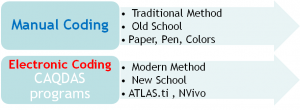Coding is the basic building block of analysis, and while it seems straightforward to code your data, it usually turns out to be quite mysterious.
The first step in any analysis is to remind yourself of the methodology you have chosen, and analysis will be impossible (or at least atheoretical, merely descriptive) if you have not chosen a methodology! This provides the context for first deciding what purpose codes will serve. For example, if you are doing narrative analysis codes may be useful in specific ways related to the methodology, such as:
- identifying narrative components, such as characters, time sequences, plot elements
- counting particular words, phrases, metaphors, and so on
- labelling the concepts within the narrative
 So codes can serve many purposes, and even within the same analysis often do serve many purposes. We are often examining the trees, but with an interest in seeing the forest.
So codes can serve many purposes, and even within the same analysis often do serve many purposes. We are often examining the trees, but with an interest in seeing the forest.
Perhaps most commonly we use codes to identify concepts/bigger ideas reflected in our data and then look for intensity of concepts and patterns among concepts. In addition, codes can be counts (of words, phrases, ideas); markers for magnitude (how much of something is present/absent, simplistically perhaps as high, medium and low); and organizational (keeping track of demographics, labelling particularly evocative quotes, or as bookmarks during the coding process). But these purposes should not be muddled together.
Occasionally the question arises: how many codes do I need? There is no answer for this question, you need as many codes as you need for the purpose they serve. And, the number of codes evolves, ebbs and flows, in relation to answering the research questions posed within a particular methodological framework.
Coding, again informed by the tenets of a methodology, may be done inductively (from the bottom up; from the data to theory), deductively (from the top down; testing a theory with the data), or most commonly abductively (moving iteratively back and forth between data and theory). This is a decision that needs to be made explicitly.
 Keeping track of codes, used for various purposes and changing, is greatly facilitated by CAQDAS… computer assisted qualitative data analysis software.
Keeping track of codes, used for various purposes and changing, is greatly facilitated by CAQDAS… computer assisted qualitative data analysis software.
 Follow
Follow
